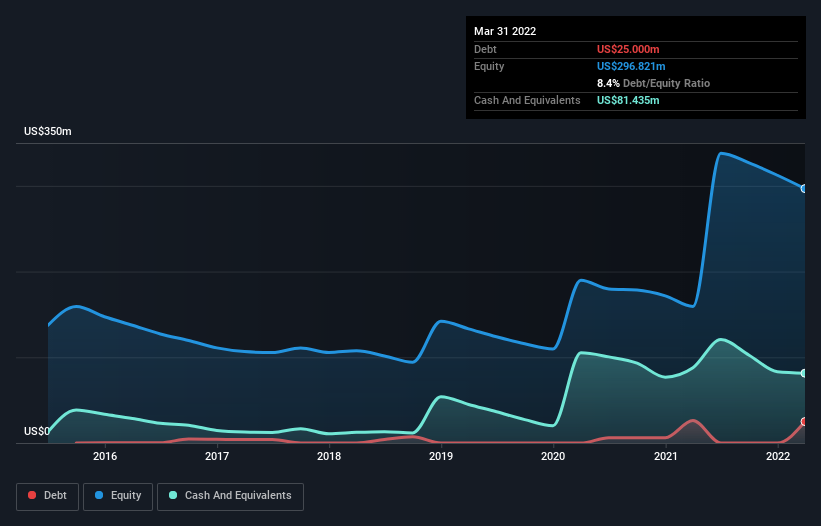Is SeaSpine Holdings (NASDAQ:SPNE) Using Too Much Debt?
David Iben put it well when he said, 'Volatility is not a risk we care about. What we care about is avoiding the permanent loss of capital.' So it seems the smart money knows that debt - which is usually involved in bankruptcies - is a very important factor, when you assess how risky a company is. Importantly, SeaSpine Holdings Corporation (NASDAQ:SPNE) does carry debt. But should shareholders be worried about its use of debt?
When Is Debt Dangerous?
Debt is a tool to help businesses grow, but if a business is incapable of paying off its lenders, then it exists at their mercy. If things get really bad, the lenders can take control of the business. However, a more usual (but still expensive) situation is where a company must dilute shareholders at a cheap share price simply to get debt under control. Having said that, the most common situation is where a company manages its debt reasonably well - and to its own advantage. The first thing to do when considering how much debt a business uses is to look at its cash and debt together.
See our latest analysis for SeaSpine Holdings
What Is SeaSpine Holdings's Net Debt?
As you can see below, SeaSpine Holdings had US$25.0m of debt at March 2022, down from US$26.2m a year prior. But on the other hand it also has US$81.4m in cash, leading to a US$56.4m net cash position.
How Strong Is SeaSpine Holdings' Balance Sheet?
According to the last reported balance sheet, SeaSpine Holdings had liabilities of US$73.0m due within 12 months, and liabilities of US$10.6m due beyond 12 months. Offsetting these obligations, it had cash of US$81.4m as well as receivables valued at US$36.1m due within 12 months. So it can boast US$33.9m more liquid assets than total liabilities.
This surplus suggests that SeaSpine Holdings has a conservative balance sheet, and could probably eliminate its debt without much difficulty. Simply put, the fact that SeaSpine Holdings has more cash than debt is arguably a good indication that it can manage its debt safely. When analysing debt levels, the balance sheet is the obvious place to start. But ultimately the future profitability of the business will decide if SeaSpine Holdings can strengthen its balance sheet over time. So if you're focused on the future you can check out this free report showing analyst profit forecasts.
Over 12 months, SeaSpine Holdings reported revenue of US$200m, which is a gain of 25%, although it did not report any earnings before interest and tax. Shareholders probably have their fingers crossed that it can grow its way to profits.
So How Risky Is SeaSpine Holdings?
We have no doubt that loss making companies are, in general, riskier than profitable ones. And we do note that SeaSpine Holdings had an earnings before interest and tax (EBIT) loss, over the last year. Indeed, in that time it burnt through US$79m of cash and made a loss of US$58m. But the saving grace is the US$56.4m on the balance sheet. That means it could keep spending at its current rate for more than two years. With very solid revenue growth in the last year, SeaSpine Holdings may be on a path to profitability. By investing before those profits, shareholders take on more risk in the hope of bigger rewards. The balance sheet is clearly the area to focus on when you are analysing debt. However, not all investment risk resides within the balance sheet - far from it. These risks can be hard to spot. Every company has them, and we've spotted 4 warning signs for SeaSpine Holdings (of which 1 is significant!) you should know about.
Of course, if you're the type of investor who prefers buying stocks without the burden of debt, then don't hesitate to discover our exclusive list of net cash growth stocks, today.
Have feedback on this article? Concerned about the content? Get in touch with us directly. Alternatively, email editorial-team (at) simplywallst.com.
This article by Simply Wall St is general in nature. We provide commentary based on historical data and analyst forecasts only using an unbiased methodology and our articles are not intended to be financial advice. It does not constitute a recommendation to buy or sell any stock, and does not take account of your objectives, or your financial situation. We aim to bring you long-term focused analysis driven by fundamental data. Note that our analysis may not factor in the latest price-sensitive company announcements or qualitative material. Simply Wall St has no position in any stocks mentioned.

 Yahoo Finance
Yahoo Finance 
